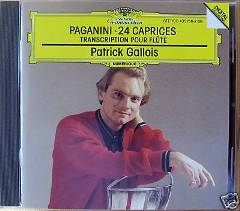Niccolo Paganini – 24 Caprices for Flute (Patrick Gallois) [1992]
Niccolo Paganini – 24 Caprices for Flute (Patrick Gallois) [1992]

01. No. 1 in E 02. No. 2 in B minor 03. No. 3 in E minor 04. No. 4 in C minor 05. No. 5 in A minor 06. No. 6 in G minor 07. No. 7 in A minor 08. No. 8 in E flat 09. No. 9 in E 10. No. 10 in G minor 11. No. 11 in C 12. No. 12 in A flat 13. No. 13 in B flat 14. No. 14 in E flat 15. No. 15 in E minor 16. No. 16 in G minor 17. No. 17 in E flat 18. No. 18 in C 19. No. 19 in E flat 20. No. 20 in D 21. No. 21 in A 22. No. 22 in F 23. No. 23 in E flat 24. No. 24 in A minor Patrick Gallois - flute
Nicoló Paganini, violinist extraordinaire, being one of the pioneering virtuoso propagandists, was often thought to be in league with the devil. Patrick Gallois has approached his own flute transcription of Paganini's 24 Caprices Op. 1 with suitable dare-devilry. Gallois's game is not laboriously to sound off every note, but rather to recreate the spirit of the individual Capriccios as suits a wind instrumentalist clutching a quick-speaking, modern flute. He sets a mass of avant-garde flute techniques over and above the initial romantic virtuosity. Fortunately, Gallois has the necessary pyro-gymnastic control and creative musicality to carry this off with flair. Most impressive are the double-stop imitations. Not only does he simultaneously sing and play, as in the eerie tremolo study (No. 6) or the evocation of a hunt (No. 9), but he alternates the melody between voice and flute with assured mobility. Harmonics and double articulation add further meat to his range of timbral colours, as does his medley of varying articulations. Double, triple and flutter-tonguing are effortlessly executed, employing a ghost-like buzzing in the Variations of No. 24, hysterical, staccato skitterings in the Allegretto of No. 20, but also lackadaisical articulation in the Andante of No. 11. Although circular breathing plays a major role in creating long melodic lines, Gallois is never afraid to take breathing time when the mood allows. His dramatic inhalations in the Amoroso of No. 21 are welcomed, as is the noise of rapid key clicks heard in Allegro assai of No. 19. Gallois likes to speak directly, without any artificial cleansing. He leaves us exhausted, but exhilarated. ---Kate Sherriff, classical-music.com
download: uploaded yandex 4shared mediafire solidfiles mega filecloudio nornar ziddu
Last Updated (Friday, 07 March 2014 20:28)








